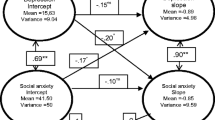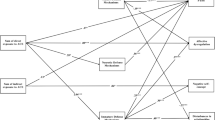Abstract
This study examines the relationship between stressful life events and defense mechanisms. Eighty seven female adolescent patients completed the Adolescent Family Inventory of Life Events and Changes (A-FILE) assessing stressors in six domains of family life, and the Defense Style Questionnaire (DSQ) assessing 19 defense mechanisms grouped into Immature, Prosocial, and Mature clusters. Increasing stressors are significantly positively correlated with a more immature defense style. Results support the hypothesis that there is an iterative relationship between immature defenses and life stressors. These findings are compatible with a regression model of defense functioning and complement our previous results linking defenses to temperament.
Similar content being viewed by others
References
Vaillant GE: Ego Mechanisms of Defense, a Guide for Clinicians and Researchers. Washington DC: American Psychiatric Press, 1992.
Sjöbæck H: The Psychoanalytic Theory of Defensive Processes. New York: John Wiley & Sons, 1973.
Freud A: the Ego and the Mechanisms of Defense, Vol 2. Madison Connecticut: International Universities Press, 1966.
Bond M, Gardner ST, Christian J, Sigal C: Empirical study of self-rated defense styles. Arch Gen Psychiat. 40:333-338, 1983.
Vaillant GE: Adaptation to Life. Canada: Little, Brown & Company, 1977.
Cramer P: The Development of Defense Mechanisms: Theory, Research, and Assessment. New York: Springer-Verlag, 1991.
Feldman SS, Araujo KB, Steiner H: Defense mechanisms in adolescents as a function of age, sex, and mental health status. J Am Acad Child Adolesc Psychiatry 34:1344-1354, 1996.
Fraiberg S: Pathological defenses in infancy. Psychoanal Q: 612-635, 1982.
Cloninger R, Svrakic DM, Prysbeck TR: Psychobiological model of temperament and character. Arch Gen Psychiat 50:975-990, 1993.
Shaw R, Ryst E, Steiner H: Temperament as a correlate of adolescent defense mechanisms. Child Psychiat Hum Dev 27:105-114, 1996.
Swanson GE: Determinants of the individual's defenses against inner conflict: Review and reformulation. In Parental Attitudes and Child Behavior, pp. 5-41 ed. Glidewell JC. Springfield Ill: Charles C Thomas, 1961.
Steiner H: Repressive adaptation and family environment. Acta Paedopsychiatrica 55:121-125, 1992.
Weinstock A: Family environment and the development of defense and coping mechanisms. J Pers Soc Psychol 5:67-75, 1967.
Thienemann M, Steiner H: Family environment of eating disordered and depressed adolescents. Int J Eating Disord 14:43-48, 1993.
Steiner H: Defense Styles in Eating Disorders. Int J Eat Disord, 9:141-151, 1990.
Jacobson AM, Beardslee W, Hauser ST, et al.: Evaluating adolescent ego defense mechanisms using clinical interviews: an empirical study of adolescent diabetic and psychiatric patients. J Adolesc 9:303-319, 1986.
McCubbin H, Patterson J: Stress: Family inventory of life events and changes. In E Filsinger (ed), A Sourcebook of Marriage and Family Assessment. Beverly Hills, CA: Sage, 1983.
American Psychiatric Association, Diagnostic and Statistical Manual of Mental Disorders, 3rd Edition, revised (DSM III-R). Washington, DC: American Psychiatric Association, 1987.
Freud S: Inhibitions, Symptoms and Anxiety. London: Hogarth Press, 1959.
Vaillant GE, Bond M, Vaillant C: An empirically validated hierarchy of defense mechanisms. Archives of General Psychiatry 43:786-794, 1986.
Perry JC, Cooper, SH: A preliminary report on defenses and conflicts associated with borderline personality disorder. J Am Psychoanal Assoc 34:863-893, 1987.
Cooper SH, Perry CJ, Arnow D: An empirical approach to the study of defense mechanisms: I. Reliability and preliminary validity of the Rorschach defense scales. J Pers Assessment, 52:187-203, 1988.
Andrews, G., MD, Pollock, C, & Stewart, G. The determination of defense style by questionnaire. Arch Gen Psychiat, 46:455-460, 1989.
Bond M, Sagala Vaillant J: An empirical study of the relationship between diagnosis and defense style. Arch Gen Psychiat 42:285-288, 1986.
Karasu T, Skodol A: Sixth axis for DSM-III psychodynamic evaluation. Am J Psychiat 137:607-610, 1980.
Feldman SS, Fisher L, Ransom DC: Is “What is good for the goose good for the gander”? Sex differences in relationships between adolescent coping and adult adaptation. J Res Adolesc 5:333-359.
Erikson SJ, Feldman SS, Steiner H: Defense mechanisms and adjustment in normal adolescents. Am J Psychiat 153:826-828, 1996.
Author information
Authors and Affiliations
Rights and permissions
About this article
Cite this article
Araujo, K., Ryst, E. & Steiner, H. Adolescent Defense Style and Life Stressors. Child Psychiatry Hum Dev 30, 19–28 (1999). https://doi.org/10.1023/A:1022666908235
Issue Date:
DOI: https://doi.org/10.1023/A:1022666908235




